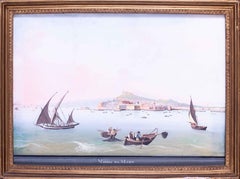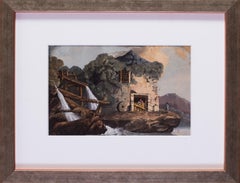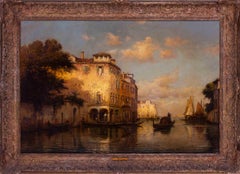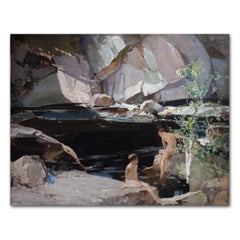Want more images or videos?
Request additional images or videos from the seller
1 of 11
Pair of small 19th Century Italian paintings of Vesuvius erupting in Naples
Price:$826.63
$936.85List Price
About the Item
- Dimensions:Height: 3.75 in (9.53 cm)Width: 5.88 in (14.94 cm)Depth: 1 in (2.54 cm)
- Medium:
- Movement & Style:
- Circle Of:Giocacchino L Pira (1839 - 1870, Italian)
- Period:
- Condition:A little waterstaining to day version, minor surface dirt to lower left on both, probably due to moulding , behind glass, in simple giltwood frames. A highly decorative pair.
- Gallery Location:Petworth, GB
- Reference Number:1stDibs: LU540312667162
About the Seller
4.9
Platinum Seller
Premium sellers with a 4.7+ rating and 24-hour response times
Established in 2010
1stDibs seller since 2017
272 sales on 1stDibs
Typical response time: 2 hours
Authenticity Guarantee
In the unlikely event there’s an issue with an item’s authenticity, contact us within 1 year for a full refund. DetailsMoney-Back Guarantee
If your item is not as described, is damaged in transit, or does not arrive, contact us within 7 days for a full refund. Details24-Hour Cancellation
You have a 24-hour grace period in which to reconsider your purchase, with no questions asked.Vetted Professional Sellers
Our world-class sellers must adhere to strict standards for service and quality, maintaining the integrity of our listings.Price-Match Guarantee
If you find that a seller listed the same item for a lower price elsewhere, we’ll match it.Trusted Global Delivery
Our best-in-class carrier network provides specialized shipping options worldwide, including custom delivery.You May Also Like
Countryside by A. Ecuyer - Gouache on paper 30x37 cm
Located in Geneva, CH
Work on ark paper
Category
1950s Academic Landscape Paintings
Materials
Gouache
$224 Sale Price
20% Off
H 14.77 in W 12.01 in D 0.12 in
Wheels of Industry Past and Present, Golden Age of Illustration - Standard Oil
Located in Miami, FL
This Golden Age of Illustration painting juxtaposes modern and ancient industrial practices. Giant eclectic generators from the current ti...
Category
Mid-20th Century Academic Landscape Paintings
Materials
Gouache, Board
$12,000 Sale Price
20% Off
H 14 in W 26 in D 3 in
MARINA DI NAPOLI - Gouache anonymous artist, Italy 2000s
Located in Napoli, IT
Gouache, also known in the French form gouache, is a type of tempera color made heavier and more opaque by the addition of a white pigment mixed with gum arabic. The result is precis...
Category
1990s Academic Landscape Paintings
Materials
Gouache
Napoleon III-Review by Edouard Detaille - Tempera - signed lower right
By Jean Baptiste Édouard Detaille
Located in PARIS, FR
This artwork might be one of two versions, the other one being in the Museum in les Invalides Paris.
Note. This version has a more accomplished academic style.
Dimensions with original gold frame 107 x 87 cm
Conditions Excellent overall, supported by an original frame withan antique glass.
EDOUARD DETAILLE
The emperor is accompanied by his aide-de-camp, Colonel Castelnau, and Marshal Canrobert. In a gilded wooden frame, under a Marie Louise blue background.
Life and time
Born in 1848 into a close-knit bourgeois family, Édouard Detaille, the eldest of eight children, displayed early talent in drawing. “He was a prodigy,” notes François Robichon. By the age of thirteen, he exhibited an astonishing surety of hand and a phenomenal sense of composition. His father, connected to Horace Vernet, encouraged him. At seventeen, after passing his baccalaureate, he entered Meissonier’s studio. This relationship, which developed into mutual affection, spared Detaille the academic detour through the École des Beaux-Arts. Rather than dictating an official art style, Meissonier, at the peak of his fame, traveled with his students, introducing them to the nuances of Titian, Rembrandt, and Rubens in Brussels and Lille.
In 1867, the Paris of “free trade” dominated the world through the technological revolutions of the Universal Exhibition, and the amiable young man, striking in appearance, discovered the salon of Princess Mathilde and the theater of Dumas fils. He even approached the Empress, noting in his journals, “Not bad, the Empress.” This observation encapsulated Detaille: he had no doubts about his talent, cultivated panache, enjoyed the company of beautiful women, and aimed to conquer the circles of power without sacrificing his freedom.
From childhood, he listened to his calling: “Before I could read, I could guess the subjects of battles, the names of famous generals, the weapons of officers and soldiers from the images I admired in the books of Norvins and Laurent de l'Ardèche.” He mingled with collectors and regularly attended military reviews on the Champs-Élysées. His first painting exhibited at the Salon in 1868, “La Halte de tambours,” was praised by critics who immediately recognized “a remarkable truth of observation and simplicity of effect.” The purchase of this work by Princess Mathilde, cousin of Emperor Louis-Napoleon, made Detaille, at twenty, an envied celebrity known to Sainte-Beuve, Théophile Gautier, the Goncourt brothers, and Flaubert. The young artist’s humanistic vision contrasted with the compositions of his predecessors, depicting soldiers in maneuvers, contemplative and resigned as war loomed.
**The Combatant’s Vision**
The Siege of Paris, where he nearly lost his life in 1870, and the deaths of two brothers in that defeat darkened his outlook. From 1871 onward, Detaille no longer concealed the cruelties of war: German riflemen mowed down by machine gun fire, cavalrymen and panicked horses caught in ambushes, fields plowed by shells strewn with dead animals. The unvarnished tragedy: “It is an absolute fact that no painter has ever rendered a battlefield covered with corpses as it is,” commented Jules Claretie. The fallen bodies still bear the appearance of life in their frozen rigidity. Detaille’s testimony of the devastating defeat and the catastrophic effects of the first total war in history was not a celebration of heroism but a lament, a “lesson in darkness.” “From war, once considered the supreme effort of human genius, we now see only melancholy and horrors,” judged one writer in response to his canvases.
“Detaille experienced the reality of combat at a young age during a war that foreshadowed the two world conflicts of the 20th century,” explains François Robichon. With great realism, Detaille painted war from the perspective of the combatant. He introduced a humanity and a critical lucidity regarding the evolution of warfare. His works intensely captured the violence and firepower of new weapons like machine guns. Before he turned thirty, Detaille had become a chronicler of these painful years. He exhibited, as a critic noted, a “striking portrait of modern war” that both French civilians and soldiers had experienced firsthand. He embodied a youth humiliated and eager for revenge. Yet this scrupulous artist also remembered, in his expansive landscapes—from the chalky plateaus of Île-de-France to the Russian plains—the lessons of Corot and Courbet. Manet was not far off. “I wouldn’t want my art to be reduced to mere patriotic art,” he asserted. “A system I often employ and love is to first execute the landscape, very effective, very tight, based on nature…” Echoing Meissonier’s advice: “Always nature, always nature!” Detaille remained close to this father figure, constructing a grand townhouse next to his mentor’s studio at 129 boulevard Malesherbes at the age of 26, having purchased 425 m² of land from the Pereire brothers. He even chose the same architect as Meissonier: Paul Boesvilwald. A bachelor and incorrigible seducer, the painter welcomed his conquests, including Valtesse de la Bigne, amidst his collections, having built his studio in the courtyard.
Diplomatic Actor
As Detaille’s fame grew, his Malesherbes townhouse quickly became a gathering place for foreign princes, politicians, and heads of state, where Juliette Adam, Léon Gambetta’s muse, offered him valuable advice. The Prince of Wales, the future Edward VII, developed a genuine friendship with the painter. “This fervent patriot, friend of Déroulède, was extraordinarily open to the world,” recounts François Robichon. In just a few years, he gained considerable social, cultural, and international stature. Received at Windsor, at the English court, he was close to Tsar Alexander III and a great friend of Félix Faure.
In this capacity, Detaille played a decisive role in the Entente Cordiale, signed in 1904 between England and France, and in the Franco-Russian alliance of 1894, thereby contributing to the Triple Entente among the three powers. An engaged witness of his time—associated with the birth of the “Ligue des Patriotes” alongside Alphonse de Neuville...
Category
Late 19th Century Academic Landscape Paintings
Materials
Gouache
$20,216
Free Shipping
H 34.25 in W 41.73 in
Orientalist View With Characters - Gouache 1894
By Paul Pascal
Located in Saint-Ouen, FR
PASCAL Paul (1832-1903)
Orientalist View With Characters
Gouache on card signed low right and dated 1894
New golden frame
Dim gouache : 42 X 58 cm
Dim Frame : 61 X 78 cm
PASCAL Paul...
Category
1890s Academic Landscape Paintings
Materials
Gouache
$6,257
H 24.02 in W 30.71 in D 1.58 in
“Dead Gull”
By John Duncan
Located in Southampton, NY
In original gold leaf pierced frame
Signed and dated lower right 1902
Sight size 7.5 x 9.5 in
Category
Early 1900s Academic Landscape Paintings
Materials
Paper, Watercolor
Black-Headed Gull
By John Duncan
Located in Southampton, NY
In original gold leaf pierced frame
Signed and dated lower left 1902
Sight size 6 x 8 in
Category
Early 1900s Academic Landscape Paintings
Materials
Paper, Watercolor
Early 19th Century English watercolour of woodland near Croxdale Hall
Located in Harkstead, GB
A very attractive and meticulously executed view of a rocky landscape within the woods dating to 1823. This would suit a library or study with its muted tones and skifull draughtsmanship.
William Nicholson (1781-1844)
Near Croxdale Hall
Signed with initials and inscribed with title and date 1823
Pen, ink and grey wash
11 x 8 inches, image only
17 x 13 inches without frame
The portrait-painter and etcher William Nicholson was born in Ovingham-on-Tyne, Northumberland, on Christmas Day 1781. His family transferred to Newcastle when his father was appointed Headmaster of the city's Grammar School. At an early age, though, Nicholson appears to have moved to Hull where he made his artistic debut, painting miniatures of officers garrisoned there. He was almost entirely self-taught, learning his craft through the close study of artworks in private and public galleries. He subsequently returned to Newcastle where he received many commissions to paint portraits of the old families of Northumberland. In 1808, he began to exhibit at the Royal Academy, continuing to do so until 1822. By 1814, Nicholson, whose mother was a Scot, had moved to Edinburgh where he set up as a miniaturist and painter in oils. Soon, however, he began to specialize in watercolour portraits. Early subjects included the actor Daniel Terry and the poet and novelist James Hogg. In 1818 he began to publish a series of Portraits of Eminent Scotsmen, etched from his own portraits and those of other painters. Besides Scott and Hogg, the subjects included the writers Robert Burns, John Wilson ('Christopher North'), and Lord Jeffrey, the painters Sir Henry Raeburn, the divines Alexander Carlyle and Alexander Cameron, the engineer James Watt, the architect John Playfair, and the song-collector and composer George Thomson...
Category
Early 19th Century Academic Landscape Drawings and Watercolors
Materials
Paper, Watercolor, Ink, Pen
$413 Sale Price
20% Off
H 11 in W 8 in D 1 in
Early English watercolour of cottage on lane in Pirbright Constable Contemporary
By Dr William Crotch
Located in Harkstead, GB
A very attractive view of a rural lane in Pirbright by this highly collectable artist who was a contemporary and friend of John Constable.
Dr William Crotch (1775-1847)
Mr Pear's House at Pirbright from the Turnpike
Signed with initials on reverse and inscribed as title and additionally " Thunder about/ 1 pm"
watercolour and pencil
4 x 6½ inches without frame
11 x 13 inches with frame
William Crotch (5 July 1775 – 29 December 1847) was an English composer and organist. According to the British musicologist Nicholas Temperley, Crotch was "a child prodigy without parallel in the history of music", and was certainly the most distinguished English musician in his day.
Crotch was a professional musician, becoming the first Principal of the Royal Academy of Music...
Category
Early 19th Century Academic Landscape Drawings and Watercolors
Materials
Paper, Watercolor, Pencil
$633 Sale Price
20% Off
H 4 in W 6.5 in D 1 in
Landscape in Provence Watercolor Painting by Francois Pascal, circa 1940
Located in Atlanta, GA
Step into the serene charm of southern France with this captivating watercolor landscape artwork by François Pascal (France, 19th century–1948). Expertly painted on paper, this work ...
Category
1940s Academic Landscape Paintings
Materials
Watercolor
$1,800
H 19.13 in W 28.38 in D 1.57 in
More From This Seller
View All19th Century Italian gouache painting of Mount Vesuvius and Naples, summertime
Located in Petworth, West Sussex
A beautiful and naive painting of Naples from the sea in summertime from the 19th Century. The beautiful light blue tones of the sea highlight the architecture of Naples and Vesuvius beyond.
Circle of Gioacchino La Pira...
Category
19th Century Academic Landscape Paintings
Materials
Paper, Gouache
Figures at a mill
Located in Petworth, West Sussex
English school, 18th Century
Figures at a mill
Gouache on paper
4.5/8 x 7.1/2 in. (11.8 x 19 cm.)
Category
19th Century Academic Landscape Paintings
Materials
Paper, Gouache
Gondolier on a Venetian backwater, oil on canvas, by Antoine Bouvard senior
By Antoine Bouvard (Marc Aldine)
Located in Petworth, West Sussex
Antoine Bouvard (French, 1882–1956)
Gondolier on a Venetian Backwater
Oil on canvas
Signed ‘Bouvard’ (lower left)
21.25 x 32 in. (54 x 81.5 cm)
In this tranquil Venetian scene, Anto...
Category
19th Century Academic Landscape Paintings
Materials
Canvas, Oil
Large British turn of the 20th Century oil painting of boys at the rockpool
Located in Petworth, West Sussex
A stunning, large scale, oil painting by British artist Harry Watson of bathers at a rockpool.
HARRY WATSON RWS ROI (BRITISH, 1871-1936)
BATHERS AT A ROCKPOOL
oil on canvas
signed ...
Category
Early 20th Century Academic Nude Paintings
Materials
Canvas, Oil
French 19th Century oil painting of The rescue of Deianara by Emile Menard
Located in Petworth, West Sussex
Emile Rene Menard (French, 1862-1930)
L`enlevement de Dejanira (The rescue of Deianara)
Oil on canvas
Signed `E R Menard’ (lower left) and inscribed with t...
Category
19th Century Academic Landscape Paintings
Materials
Canvas, Oil
Large landscape watercolour by Cornish artist Fred Yates of La Riviere Lafare
By Fred Yates
Located in Petworth, West Sussex
A beautiful and serene watercolour painting by Cornish artist Fred Yates. This large example of his work highlights his ability to balance colour and light in an expressive manner. ...
Category
21st Century and Contemporary Expressionist Landscape Paintings
Materials
Watercolor
Recently Viewed
View AllMore Ways To Browse
Small Paintings In Frames
Small 19th Century Paintings
Vesuvius Painting
Paintings Of Sailors
Gouache Naples
Gouache Vesuvius
After The Storm
Painting Florence Italy
Pastoral Landscape Oil Painting
18th Century European Landscapes Oil Paintings
American Western Landscapes
Canal Boats
Harris Oil
New Jersey 19th Century Painting
Oil Paintings By Louis
Old House Paintings
Pope John Paul Ii
Rockport Massachusetts



